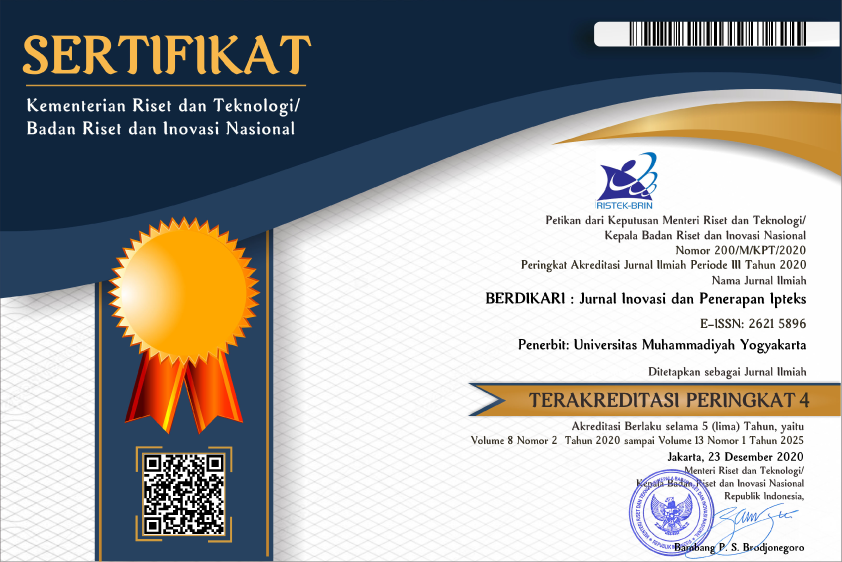Pemanfaatan Limbah Kotoran Sapi untuk Produksi Batu Bata Ramah Lingkungan dan Tahan Gempa
DOI:
https://doi.org/10.18196/bdr.8172Keywords:
dung waste, cow cattle, brick, income, economyAbstract
Cow dung waste at Srunen hamlet, Glagaharjo village, Cangkringan, Sleman is recorded to be high in quantity since it also has a high population of dairy cows. The high volume of cow dung waste leads to environment pollution, either water or air pollution. The environment pollution it causes may further trigger some problems regarding society’s health, safety and comfort. Thereby, the abundant quantity of cow dung waste needs to be well-managed and oriented for economics. One of among other technologies to manage cow dung waste which had never been implemented before is to utilize the waste as the raw material component of brick. Such brick production technology is not only environmentally friendly but is also resistant toward earthquake. This technology was introduced and implemented during the Community Service program at Glagaharjo village. The program was implemented through the methods of assessment and education, as well as feasibility test. Training and practice were conducted to adopt the technology of environmentally friendly and earthquake resistant cow dung brick. Further, the product was tested for its feasibility as construction material. The success of the program is shown from the society’s ability to produce the environmentally friendly and earthquake resistant brick which has also increased society’s income and the hamlet’s economyReferences
Anom Wiryasa, N., & Sudarsana, I. (2009). Pemanfaatan Lumpur Lapindo Sebagai Bahan Substitusi Semen Dalam Pembuatan Bata Beton Pejal. Jurnal Ilmiah Teknik Sipil, 13(1), 39–46.
I Made Nada, Ida Bagus Suryatmaja. (2010). Jurnal ilmiah kurva teknik. 17–35.
Handayani, S. (2010). Kualitas Batu Bata Merah. Kualitas Batu Bata Merah, 12(Handayani Sri), 41–50.
Haryanti, N. H. (2015). Kuat Tekan Bata Ringan Dengan Bahan Campuran Abu Terbang PLTU Asam-Asam Kalimantan Selatan. Fisiki FLUX, 12, 20–30.
Sudarsana, I., Made Budiwati, I., & Angga Wijaya, Y. (2011). Karakteristik Batu Bata Tanpa Pembakaran Terbuat Dari Abu Sekam Padi Dan Serbuk Batu Tabas. Jurnal Ilmiah Teknik Sipil, 15(1), 93–101.
Sukamta, S., Abdus Shomad, M., & Wisnujati, A. (2017). Pengelolaan Limbah Ternak Sapi Menjadi Pupuk Organik Komersial di Dusun Kalipucang, Bangunjiwo, Bantul, Yogyakarta. BERDIKARI : Jurnal Inovasi Dan Penerapan Ipteks, 5(1), 1–10. https://doi.org/10.18196/bdr.5113
Suseno, H., Prastumi, P., Susanti, L., & Setyowulan, D. (2012). Pengaruh penggunaan bottom ash sebagai pengganti tanah liat pada campuran bata terhadap kuat tekan bata. Jurnal Rekayasa Sipil, 6(3), 264–271. Retrieved from http://rekayasasipil.ub.ac.id/index.php/rs/article/view/226
Yazidun Niam, A. (2016). Pengaruh Treatment Lumpur Lapindo Terhadap Mutu Batu Bata Bahan Lumpur Lapindo Berdasarkan Sni 15-2094-2000. Rekayasa Teknik Sipil, 1(1/REKAT/17), 1–7.
Downloads
Additional Files
Published
Issue
Section
License
Copyright
Authors retain copyright and grant BERDIKARI Jurnal Inovasi dan Penerapan IPTEK the right of first publication with the work simultaneously licensed under an Attribution 4.0 International (CC BY 4.0) that allows others to remix, adapt and build upon the work with an acknowledgment of the work's authorship and of the initial publication in BERDIKARI Jurnal Inovasi dan Penerapan IPTEK.
Authors are permitted to copy and redistribute the journal's published version of the work (e.g., post it to an institutional repository or publish it in a book), with an acknowledgment of its initial publication in BERDIKARI Jurnal Inovasi dan Penerapan IPTEK
License
Articles published in the BERDIKARI Jurnal Inovasi dan Penerapan IPTEK) are licensed under an Attribution 4.0 International (CC BY 4.0) license. You are free to:
- Share — copy and redistribute the material in any medium or format.
- Adapt — remix, transform, and build upon the material for any purpose, even commercially.
This license is acceptable for Free Cultural Works. The licensor cannot revoke these freedoms as long as you follow the license terms. Under the following terms:
- Attribution — You must give appropriate credit, provide a link to the license, and indicate if changes were made. You may do so in any reasonable manner, but not in any way that suggests the licensor endorses you or your use.
- No additional restrictions — You may not apply legal terms or technological measures that legally restrict others from doing anything the license permits.




